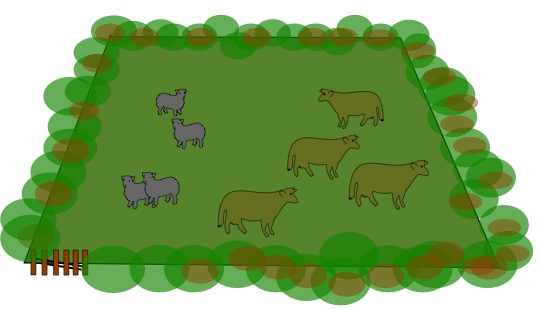Copyright © University of Cambridge. All rights reserved.
'Cows and Sheep' printed from https://nrich.maths.org/
Show menu
Why do this problem?
This problem challenges children to think in an organised way - the main aim is to help them develop a system or logical approach for tackling it.
Possible approach
Begin by showing the group the picture in the problem. Rather than talking through the text underneath it, ask some questions about what they see, for example:
- What can you tell me about the number of sheep and cows in the picture?
- How many cows can each sheep see?
- How many cows can each cow see?
- How does the number of sheep a cow can see relate to the number of cows it can see?
Children might well say things like "each cow can see more sheep than cows", so ask them to be more exact. This may lead to statements like "each cow can see one more sheep than cows", or "each cow can see one less cow than sheep".
Try looking at the first field together. Simply read out what it says and ask the children to think about HOW they might find out the number of cows and sheep. Invite suggestions from the class. Choose a way to try which captures the idea of trial and improvement. If the children haven't had much experience of this, you might want to model a way for them as a start. So, focusing either on
the sheep's view or the cows' view, try the smallest number that there could be to start with, increasing this one at a time, checking to see whether the results fit with the information at each stage. Emphasise that this way of approaching the problem, (trying the simplest case and then working up a step at a time) is a very good way of going about solving it as it means no possibilities are
left out.
Key questions
What shall we try first?
If there was just one cow, how many sheep would it see? How many cows would it see? Does this fit the clues?
If not, imagine there were two cows. How many sheep would each one see? How many cows would each one see? Does this fit the clues?
How about three cows ...?
Possible extension
Invite children to create some similar questions/situations of their own. They could include more than two different kinds of animal.
Possible support
Having objects available to represent the animals would be a good idea (for example lots of multilink cubes in two different colours).
